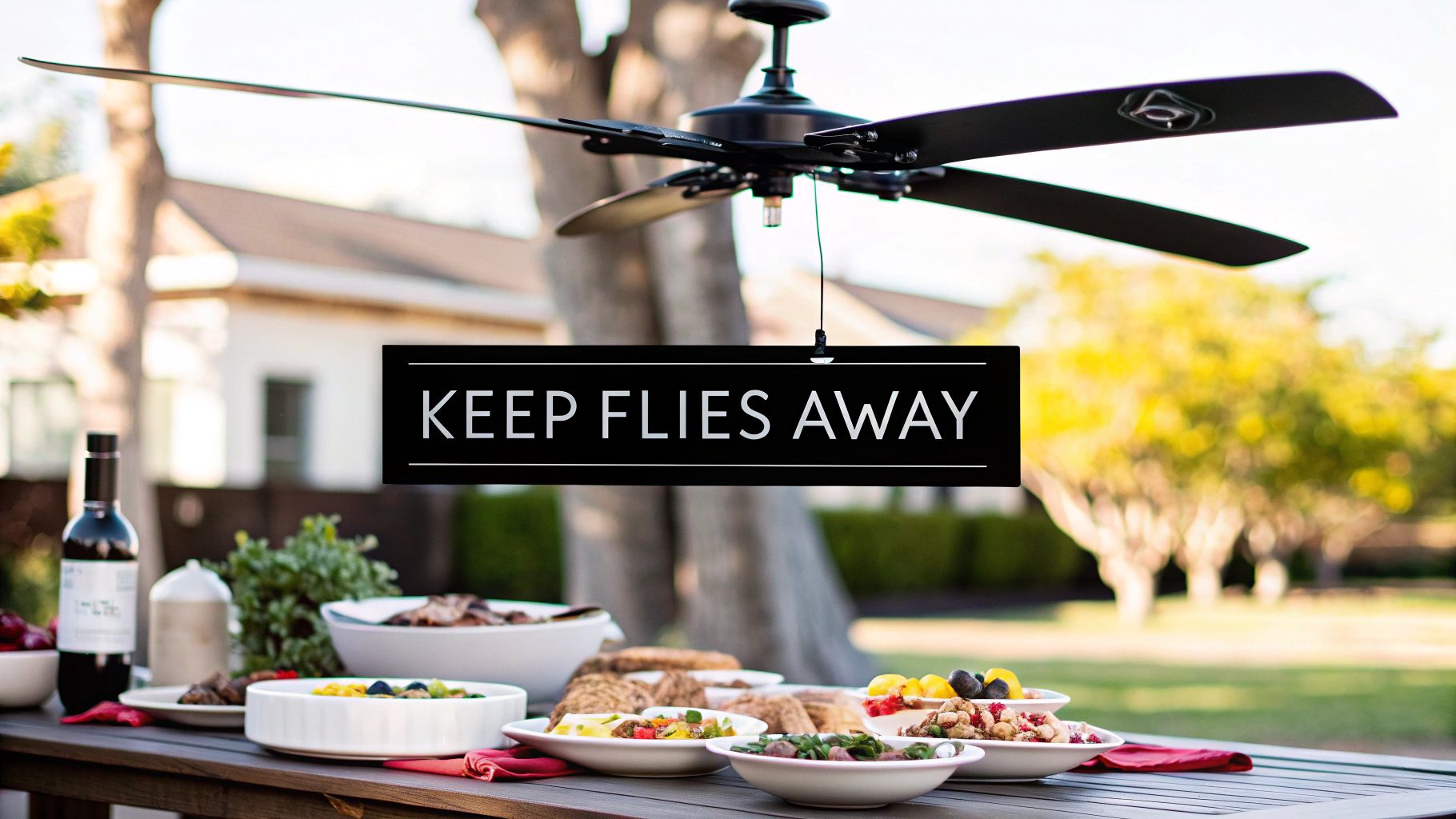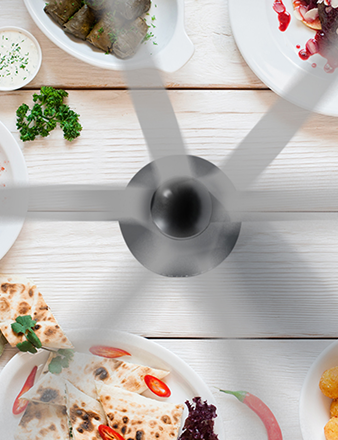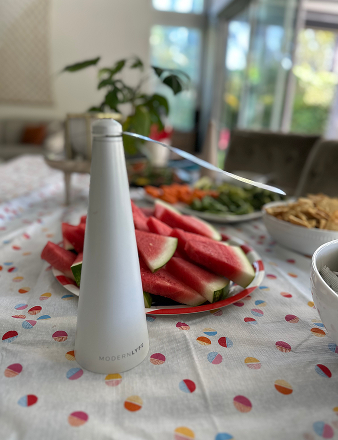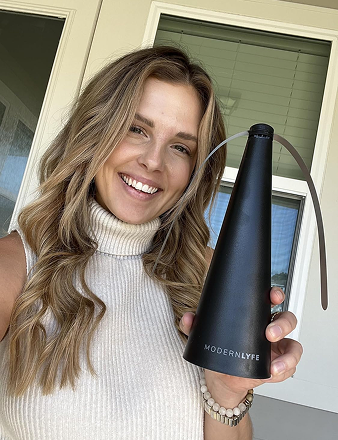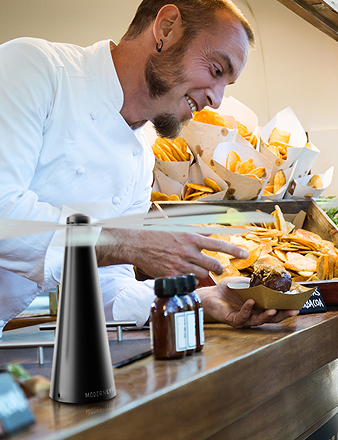A fly cover for food is the essential tool for any outdoor meal. It's a simple shield, whether it's a mesh pop-up tent or a battery-powered fan, designed with one clear purpose: to create a barrier that keeps flies and other bugs out of your food.
Stop Flies From Ruining Your Meal

We've all been there. You lay out the perfect barbecue spread, but the second you sit down, the buzzing starts. Instead of enjoying your meal, you're swatting at flies.
This is more than just annoying—it's a health risk. Flies carry harmful bacteria, and every time one lands on your potato salad, it can contaminate it. Covering your food is a simple step to protect your family and friends.
More people are catching on. The global market for fly traps and covers is projected to hit USD 517 million by 2035, proving that consumers are getting serious about pest-related health concerns.
A food cover lets you reclaim your dining experience. It ends the frustrating battle with bugs so you can focus on the food and the people you're with.
Fortunately, you have excellent options to solve this problem. The most common solutions include:
- Mesh Tents: Simple pop-up covers that create a physical wall.
- Plastic Domes: Rigid covers, ideal for single plates or small bowls.
- Fly Fans: An active solution that uses soft, spinning blades to create a no-fly zone.
Learning how to keep flies away from food is the key to enjoying your time outdoors. Let’s compare these options so you can choose the right defense for your next gathering.
Comparing Fly Cover for Food Options
Not all fly covers are created equal. You have choices ranging from simple barriers to modern, active deterrents. Understanding the differences will help you pick the right tool for your next barbecue or picnic.
Classic options like mesh food tents and plastic cloches are straightforward and affordable. They work by placing a physical wall between your food and any pests. A mesh tent is great for a large platter, while a cloche is perfect for a single plate.
However, their static design is their biggest weakness. They only protect what's directly underneath, and flies can easily sneak in the moment you lift the cover. Your shield can quickly become a trap.
This chart shows just how effective a fly cover can be, looking at everything from fly landings to long-term cost-effectiveness.

As you can see, using a cover dramatically reduces fly contact, and its reusability makes it a smart long-term investment.
A Modern Approach to Food Protection
The Modern Lyfe fly fan changes the game entirely. Instead of a static wall, a fly fan creates an active, pest-free zone around your food. It acts less like a fence and more like a 360-degree security guard for your entire table.
The fan's soft blades spin harmlessly, creating a gentle air current that flies avoid. The real innovation lies in the holographic patterns on the blades. They refract light in a way that disrupts a fly's compound eyes, sending them flying in the other direction—all without chemicals or noise. It actively stops them from ever wanting to land.
A fly fan doesn’t just cover your food; it defends the space around it. This active deterrent provides broader, more reliable protection for buffet-style setups where covers are constantly being lifted.
To help you decide, let's compare these options side-by-side.
Fly Cover For Food Feature Comparison
Here’s a quick breakdown of how the main types of fly covers stack up.
| Feature | Mesh Food Tent | Plastic Cloche | Modern Lyfe Fly Fan |
|---|---|---|---|
| Effectiveness | Moderate; can trap pests | High for a single dish | High; actively repels |
| Coverage Area | Limited to tent size | Limited to one dish | 360-degree radius |
| Ease of Use | Simple setup | Very simple | Turn on and place |
| Power Source | None | None | Batteries (AA) |
| Pest Trapping | High risk | Moderate risk | No risk |
While traditional covers work for simple jobs, the active defense of a fly fan offers a more complete and convenient way to keep your entire meal pest-free.
How a Fly Fan Offers Superior Protection

A mesh cover just puts up a wall. A fly fan takes a smarter approach by actively creating a no-fly zone, convincing pests to stay away entirely. It's a clever, multi-faceted deterrent that protects a wide area without chemicals or buzzing.
The magic is in the soft, spinning blades, which feature special holographic patterns that catch and refract light. For a fly's sensitive compound eyes, this constant flash of light is disorienting. It signals danger, so they instinctively avoid the area.
A fly fan doesn’t just block pests—it convinces them to leave. This active repulsion is what makes it a superior fly cover for food, especially for large buffet tables where passive covers are impractical.
This active defense provides true 360-degree coverage that a mesh tent can't match. You aren't just protecting the food directly underneath; you're protecting the whole table. Imagine enjoying a picnic without constantly swatting at flies. That’s the peace of mind a fly fan delivers. Our guide on fly fans for food explores this technology in more detail.
Safe and Silent Operation
One of the best features is its seamless operation. The motor is whisper-quiet, so it won’t interrupt your conversations or spoil a peaceful barbecue.
The blades are also completely safe. Made from soft, flexible material, they're engineered to stop immediately if touched by a curious child's hand. No nicks, no tears—just harmless protection.
While some insects are a growing food source—the global edible insects market is expected to reach USD 4.38 billion by 2030, per Grand View Research—we still need to keep the uninvited ones off our plates. A fly fan is an essential, eco-friendly tool for ensuring only your chosen ingredients make it to the table.
Get the Most from Your Fly Fan

Simply turning on your fly fan helps, but smart placement takes its effectiveness to the next level. Think of it as setting up a defensive perimeter around your food.
For the best results, position your fans so their protective zones overlap. The goal is to create a continuous, invisible barrier with no gaps for flies to slip through. This keeps every dish—from the burgers to the dessert—completely untouched.
Effective coverage isn't just about having a fly fan; it's about placing it where pests are most likely to gather. By anticipating their targets, you create a much stronger defense.
A little forethought turns a clever gadget into your best defense against winged pests.
Optimal Placement and Care
Follow these simple guidelines to set up the perfect barrier and keep your device in top shape for years.
- Mind the Gaps: Place one fan for every 2-3 feet of table space. This creates a seamless air current that repels flies.
- Target Sweet Spots: Position fans next to foods flies love, like grilled meats, desserts, and sugary drinks. This stops them before they can land.
- Power Up: Always use fresh, high-quality batteries for the best performance and longest run time. Keep a spare set on hand for longer events.
- Clean and Store Properly: After use, wipe the blades and base with a damp cloth. Store your fly fan in a cool, dry place to protect its motor and keep it looking new.
With the right setup, your fly fan becomes an even more powerful fly cover for food, giving you complete peace of mind to enjoy your meal.
Creative Uses for Your Food Fly Cover
A fly cover for food is a lifesaver at a barbecue, but its usefulness extends far beyond the patio. This versatile gadget can solve pest problems in places you might not expect.
Imagine you've just baked fresh cookies. Instead of using plastic wrap, which traps steam and can make them soggy, place a fly fan nearby. Your treats can cool in the open air while a gentle breeze creates a no-fly zone.
The same principle works around the house. A fly fan is a game-changer for keeping your pet’s food bowl free of bugs, especially on a porch or deck.
Beyond the Home Kitchen
A quality food fly cover is incredibly adaptable, with uses in various commercial and recreational settings.
- Farmers Markets: Vendors can keep displays of fresh produce, baked goods, and samples hygienic and appealing.
- Camping Trips: A portable, battery-operated fly fan is perfect for keeping your campsite kitchen clean during food prep.
- Creative Projects: Need to protect drying crafts? A fan keeps dust and pests off freshly painted ceramics or an iced cake without disturbing airflow.
The true value of a modern fly fan is its adaptability. It’s not just a seasonal gadget for picnics; it’s a year-round solution for maintaining hygiene wherever food is present.
Controlling fly populations is serious business. The black soldier fly industry, projected to hit USD 5.60 billion by 2035 according to Meticulous Research, shows how critical fly management is for preventing contamination on a massive scale. This highlights the bigger picture of why keeping flies off our food matters.
Ultimately, a simple fly fan is your ultimate dining ally, ready to protect your meals in any situation.
Your Fly Cover Questions, Answered
Even after deciding a fly cover is right for you, practical questions can come up. Here are clear answers to the most common ones.
How many fly fans do I need?
For a standard rectangular picnic table, two fans is ideal. Place one at each end to create overlapping zones of protection that cover the entire spread. For a smaller, round table, one fan in the center is usually enough.
The goal is to leave no gaps. For a long buffet table, a good rule of thumb is one fan every 2 to 3 feet to create an unbroken barrier.
Are fly fans safe around kids and pets?
Absolutely. Safety is a core design feature. The blades are made from a soft, flexible material that is completely harmless.
They also feature soft-stop technology. The moment a blade is touched by a small hand or a curious pet's nose, the motor instantly stops. This makes them a worry-free choice for family gatherings.
Modern fly fans are designed to be effective without being dangerous. They keep pests away without adding new risks for your family, making them practical for any get-together.
Can I use a fly fan indoors?
Yes, and they work very well inside. A single housefly can be a major nuisance in the kitchen. Place a fly fan on your counter to guard a cake while it cools or protect a fruit bowl from pests. It's a simple, chemical-free solution for your home.
Do the shiny patterns on the blades actually work?
They do, and the science is clever. Flies see through compound eyes, which are highly sensitive to light and motion. The holographic patterns on the blades refract light, creating a chaotic visual that flies find disorienting.
This visual disruption scrambles their navigation, and they instinctively fly away. It doesn't harm them—it just convinces them your meal is a terrible place to land.
Ready to reclaim your meals from buzzing pests? The Modern Lyfe fly fan is a quiet, safe, and effective way to guard your food, indoors and out. Discover the perfect solution for your home at https://modernlyfe.com and start enjoying peaceful, pest-free dining.
